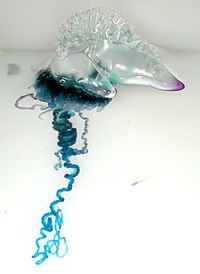
Pomolic acid reduces contractility and modulates excitation‐contraction coupling in rat cardiomyocytes
Sign Up to like & getrecommendations! Published in 2019 at "European Journal of Pharmacology"
DOI: 10.1016/j.ejphar.2019.02.016
Abstract: Abstract Pomolic acid (PA) isolated from Licania pittieri has hypotensive effects in rats, inhibits human platelet aggregation and elicits endothelium‐dependent relaxation in rat aortic rings. The present study was designed to investigate the effects of… read more here.
Keywords: excitation contraction; rat; pomolic acid; contraction coupling ... See more keywords

Multi-species transcriptomics reveals evolutionary diversity in the mechanisms regulating shrimp tail muscle excitation-contraction coupling.
Sign Up to like & getrecommendations! Published in 2020 at "Gene"
DOI: 10.1016/j.gene.2020.144765
Abstract: The natural flight response in shrimp is powered by rapid contractions of the abdominal muscle fibres to propel themselves backwards away from perceived danger. This muscle contraction is dependent on repetitive depolarization of muscle plasma… read more here.
Keywords: contraction coupling; muscle; muscle excitation; contraction ... See more keywords

Human Cardiac Fibroblasts Engage the Sarcoplasmic Reticulum in Induced Pluripotent Stem Cell-Derived Cardiomyocyte Excitation-Contraction Coupling.
Sign Up to like & getrecommendations! Published in 2018 at "Journal of the American College of Cardiology"
DOI: 10.1016/j.jacc.2018.06.028
Abstract: Ca2+-induced Ca2+ release (CICR), the process whereby a small influx of Ca2+ across the sarcolemma triggers a significantly larger Ca2+ release from the sarcoplasmic reticulum (SR), is at the heart of efficient cardiac excitation–contraction coupling… read more here.
Keywords: excitation contraction; sarcoplasmic reticulum; contraction coupling;

Effects of Extracellular Potassium on Calcium Handling and Force Generation in a Model of Excitation-Contraction Coupling in Skeletal Muscle.
Sign Up to like & getrecommendations! Published in 2021 at "Journal of theoretical biology"
DOI: 10.1016/j.jtbi.2021.110656
Abstract: It is well-established that extracellular potassium (Ko+) accumulation reduces muscle fiber excitability, however the effects of Ko+ on the excitation-contraction coupling (ECC) pathway are less understood. In vivo and in vitro studies following fatiguing stimulation… read more here.
Keywords: contraction coupling; model; extracellular potassium; force ... See more keywords

P.11 Percutaneous endoscopic gastrostomy in patients with Duchenne muscular dystrophy compared with amyotrophic lateral sclerosis and Parkinson syndrome
Sign Up to like & getrecommendations! Published in 2017 at "Neuromuscular Disorders"
DOI: 10.1016/j.nmd.2017.06.041
Abstract: Tuesday 3 October 2017 12:30–16:00 WMS Executive Board Meeting – Hôtel France & Chateaubriand 14:00–18:00 Registration opens Setting up of posters 18:00–18:45 Opening Ceremony – Auditorium Chateaubriand 18:45–21:00 Welcome Reception – Grand Large room and… read more here.
Keywords: auditorium chateaubriand; percutaneous endoscopic; excitation contraction; contraction coupling ... See more keywords

Multiple Sequence Variants in STAC3 Affect Interactions with CaV1.1 and Excitation-Contraction Coupling.
Sign Up to like & getrecommendations! Published in 2020 at "Structure"
DOI: 10.1016/j.str.2020.05.005
Abstract: STAC3 is a soluble protein essential for skeletal muscle excitation-contraction (EC) coupling. Through its tandem SH3 domains, it interacts with the cytosolic II-III loop of the skeletal muscle voltage-gated calcium channel. STAC3 is the target… read more here.
Keywords: contraction coupling; multiple sequence; sh3 domains; sequence variants ... See more keywords

Na+ microdomains and sparks: Role in cardiac excitation-contraction coupling and arrhythmias in ankyrin-B deficiency.
Sign Up to like & getrecommendations! Published in 2019 at "Journal of molecular and cellular cardiology"
DOI: 10.1016/j.yjmcc.2019.02.001
Abstract: Cardiac sodium (Na+) potassium ATPase (NaK) pumps, neuronal sodium channels (INa), and sodium calcium (Ca2+) exchangers (NCX1) may co-localize to form a Na+ microdomain. It remains controversial as to whether neuronal INa contributes to local… read more here.
Keywords: contraction coupling; role; ca2; neuronal ina ... See more keywords

Compartmentalized β1-Adrenergic Signaling Synchronizes Excitation-contraction Coupling Without Modulating Individual Ca2+ Sparks in Healthy and Hypertrophied Cardiomyocytes.
Sign Up to like & getrecommendations! Published in 2020 at "Cardiovascular research"
DOI: 10.1093/cvr/cvaa013
Abstract: AIMS β-Adrenergic receptors (βARs) play pivotal roles in regulating cardiac excitation-contraction (E-C) coupling. Global signaling of β1ARs upregulates both the influx of Ca2+ through sarcolemmal L-type Ca2+ channels (LCCs) and the release of Ca2+ from… read more here.
Keywords: ca2 sparks; contraction coupling; excitation; ca2 ... See more keywords

Increased SERCA2a sub-cellular heterogeneity in right-ventricular heart failure inhibits excitation-contraction coupling and modulates arrhythmogenic dynamics
Sign Up to like & getrecommendations! Published in 2022 at "Philosophical Transactions of the Royal Society B: Biological Sciences"
DOI: 10.1098/rstb.2021.0317
Abstract: The intracellular calcium handling system of cardiomyocytes is responsible for controlling excitation-contraction coupling (ECC) and has been linked to pro-arrhythmogenic cellular phenomena in conditions such as heart failure (HF). SERCA2a, responsible for intracellular uptake, is… read more here.
Keywords: excitation contraction; heterogeneity; heart failure; contraction coupling ... See more keywords

Feedback contributions to excitation–contraction coupling in native functioning striated muscle
Sign Up to like & getrecommendations! Published in 2023 at "Philosophical Transactions of the Royal Society B: Biological Sciences"
DOI: 10.1098/rstb.2022.0162
Abstract: Skeletal and cardiac muscle excitation–contraction coupling commences with Nav1.4/Nav1.5-mediated, surface and transverse (T-) tubular, action potential generation. This initiates feedforward, allosteric or Ca2+-mediated, T-sarcoplasmic reticular (SR) junctional, voltage sensor-Cav1.1/Cav1.2 and ryanodine receptor-RyR1/RyR2 interaction. We review… read more here.
Keywords: excitation contraction; contraction coupling; nav1 nav1; muscle ... See more keywords

Long-Term Regulation of Excitation–Contraction Coupling and Oxidative Stress in Cardiac Myocytes by Pirfenidone
Sign Up to like & getrecommendations! Published in 2018 at "Frontiers in Physiology"
DOI: 10.3389/fphys.2018.01801
Abstract: Pirfenidone (PFD) is used to treat human pulmonary fibrosis. Its administration to animals with distinct forms of cardiovascular disease results in striking improvement in cardiac performance. Here, its functional impact on cardiac myocytes was investigated.… read more here.
Keywords: cardiac myocytes; contraction coupling; pfd; contraction ... See more keywords